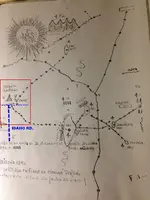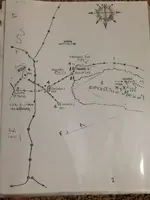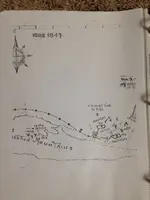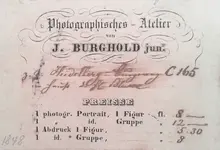You are using an out of date browser. It may not display this or other websites correctly.
You should upgrade or use an alternative browser.
You should upgrade or use an alternative browser.
The Peralta Stone Maps, Real Maps to Lost Gold Mines or Cruel Hoax?
- Thread starter Oroblanco
- Start date
sgtfda
Bronze Member
wrmickel1
Bronze Member
- Joined
- Nov 7, 2011
- Messages
- 1,854
- Reaction score
- 1,399
- Golden Thread
- 0
- Location
- Jamestown ND
- Detector(s) used
- Garrett 2500
- Primary Interest:
- Other
Well Sarg
Map 1 is the military road north with Goldfield being the Peralta holdings and the Dutchmen's
And the Palmer Mine being the Gonzalas holdings.
I'd say there fake 100 percent
babymick1
Map 1 is the military road north with Goldfield being the Peralta holdings and the Dutchmen's
And the Palmer Mine being the Gonzalas holdings.
I'd say there fake 100 percent
babymick1
wrmickel1
Bronze Member
- Joined
- Nov 7, 2011
- Messages
- 1,854
- Reaction score
- 1,399
- Golden Thread
- 0
- Location
- Jamestown ND
- Detector(s) used
- Garrett 2500
- Primary Interest:
- Other
Howdy Matthew,
I am in agreement with markmar, the only relation these "Jesuit" maps have with the PSM's is that they are someones interpretation of where the PSM's lead. Assuming they were Jesuit, they added the Jesuit symbol, and used the other symbols found on the stone maps to form their own version, not knowing what those symbols stand for. Such maps would lead others to believe they are blueprints to the PSM's.
You and others have already pointed out the places that did not yet have a name in the Jesuit era. One other thing is the lack of wear and tear that the Peralta/Fish map has which would not be as old as those maps is they were real.
You seem to believe that the PSM's were found by the Camino Viejo bridge? This is not so, and eliminates Travis as the maker. I looked for Somehikers g.e. image of where the PSM's were found but can't find it. Many knew that Travis believed the PSM's led to Hewitt Canyon, but just because he stumbled on them didn't mean he understood them.
Homar
Hewitt Canyon you say here's the trail marker for this place
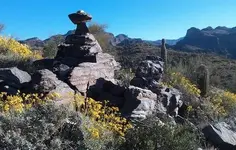
Now I've never been there, but someone is selling Gold Claims on trulia.com
So I borrowed the pic, Here my take on this monument. There should be three streams or washes there that produce gold and a hard rock mine.
So if anyone knows the area let me know how I did at reading this monument
babymick1
Cubfan64
Silver Member
- Joined
- Feb 13, 2006
- Messages
- 3,001
- Reaction score
- 2,856
- Golden Thread
- 0
- Location
- New Hampshire - USA
- Detector(s) used
- Fisher CZ21, Teknetics T2 & Minelab Sovereign GT
- Primary Interest:
- All Treasure Hunting
Cubfan64, do you know for a fact that the Das Lucas photo was a Tintype or are you taking others word for that is what it is?
The paper maps have a date of 1892 on them.
View attachment 1487306
I'm not an expert, but I've seen and held the supposed tintype photo of a young Jacob Waltz and from what I recall it fit the description of a tintype in that it was on a fairly thin piece of metal with "jacob walzer" crudely punched into the sheet on one side and "heidelberg" punched on the other side. From what I've read of daguerreotypes, they are much more inflexible and fairly fragile.
Like I've said, I could be wrong. If it is truly a tintype though, I'm just not sure the age and timeframe jive.
markmar
Silver Member
- Joined
- Oct 17, 2012
- Messages
- 4,279
- Reaction score
- 6,516
- Golden Thread
- 0
- Primary Interest:
- All Treasure Hunting
I don't know what makes some treasure hunters to believe the stone maps are related to a Jesuit treasure .
IMO , this treasure predate Columbus , but was found and maped by a Franciscan - Spanish secret cooperation .
The Jesuits ( using the CP map ) and the Peraltas ( using the King's land grant ) came later in this quest , and both made their own temporary separate caches ( with the Jesuit to become a permanent ) , independent of the Santa Fe treasure .
IMO , this treasure predate Columbus , but was found and maped by a Franciscan - Spanish secret cooperation .
The Jesuits ( using the CP map ) and the Peraltas ( using the King's land grant ) came later in this quest , and both made their own temporary separate caches ( with the Jesuit to become a permanent ) , independent of the Santa Fe treasure .
Last edited:
sailaway
Hero Member
- Joined
- Mar 2, 2014
- Messages
- 623
- Reaction score
- 816
- Golden Thread
- 0
- Primary Interest:
- All Treasure Hunting
This might be who may have taken the photo:Silver, mercury and gold were the elements involved in the first truly successful photographic process: the daguerreotype.
Daguerreotype process-A series of highly polished sheets of silver-plated copper were exposed to the fumes of iodine, and bromine forming a light sensitive layer of silver halide approximately one hundred micrometers thick. One of the reasons why daguerreotypes images look so natural is that they sometimes appear to have natural colors in them. Just to be clear we are not referring to painted daguerreotypes that have had colors applied to their surface. Claude Felix Abel Niépce de Saint-Victor conducted experiments with silver chloride on silver plates, using a modified chemical coating process. He found that he got better results using solutions of copper chloride and ferric chloride rather than hydrochloric acid.
From 1840 to 1848 approximately 48 itinerant daguerreotypists found their way to Schleswig — Holstein. They were from the nearby city of Hamburg but also came from Prussia, Denmark, France and Austria, Bavaria, England, the Netherlands, Saxony and Switzerland. At first many operated daguerreotyping as sideline, like the gymnastic artist and waxworks owner Carl Barthold from Hamburg. He advertised in February 1846 in Schleswig that he will daguerreotype in the morning and be a showman in the evening. The education of only a few photographers canAndres Von Ettinghausen, born 1796 in Heidelburg, Germany. He set up the first temporary photography studio at the summer home in Oct. 1839 after acquiring a new Giroux camera (#26 handmade by Alphonse Giroux for L. J. M. Daguerre) in Paris that year. He displayed his own print sets at the Institute of Viennese University on 22 Nov., 1839. Where he showed his photos of the Rhine River, the first Micro photographs and his experimental work with polarized light. He taught Photography from 1863 to 1866 at the University.
Encyclopedia of nineteenth-century photography
be reconstructed, e.g. the trained actor Carl Heinrich Neupert (1803-1857). After his move from Hamburg to Christiania he first produced art flowers. When the daguerreotypist Carl Ferdinand Stelzner (1804-1894) stayed and worked in Christiania for a month in August 1843 , Neupert learned the new craft from him. Eight months later, in May 1844, he announced in the newspaper, that he has succeeded in making good portraits. In 1842, Swiss Jean Baptiste Isenring (1796-1860) provided headlines in the Munich press. He had ordered to get built a heatable “Sonnenwagen” (sun wagon), which was furnished with a bed, a desk and a portrait studio.
https://www.fotomuseum.be/content/dam/fomu/pdf's/Daguerreotype Journal_Issue 1_2014_11.pdf
Attachments
Last edited:
sailaway
Hero Member
- Joined
- Mar 2, 2014
- Messages
- 623
- Reaction score
- 816
- Golden Thread
- 0
- Primary Interest:
- All Treasure Hunting
Mick you need to look at my photo close, the spots from map can be seen in the picture and neither of those spots are Goldfield. I have other angles of view that show Goldfield, but am not showing them for a reason. There is a reason the claims are for sale in Hewitt Canyon, just like GPAA did not renew their claim in that area.
wrmickel1
Bronze Member
- Joined
- Nov 7, 2011
- Messages
- 1,854
- Reaction score
- 1,399
- Golden Thread
- 0
- Location
- Jamestown ND
- Detector(s) used
- Garrett 2500
- Primary Interest:
- Other
Mick you need to look at my photo close, the spots from map can be seen in the picture and neither of those spots are Goldfield. I have other angles of view that show Goldfield, but am not showing them for a reason. There is a reason the claims are for sale in Hewitt Canyon, just like GPAA did not renew their claim in that area.
But do you know the area, Are there 3 washes and a hard rock mine there, But the map is a Modern interpretation of the PMS.
Babymick1
sailaway
Hero Member
- Joined
- Mar 2, 2014
- Messages
- 623
- Reaction score
- 816
- Golden Thread
- 0
- Primary Interest:
- All Treasure Hunting
I know the area well, as I have been in the creek bed many times. there are hundreds of washes that drain into the creek in that canyon. There is a old conctete/rock ore chute across the creek not far from the picture. The area is well marked with modern BLM claim markers so have not sampled there, but have walked around and found nothing that made me want a closer look. Best looking spot was the natural spot of where the rocks vertical wall is on the creek side of the picture.(looks to be a small vein of Galena, also called lead glance, is the natural mineral form of lead sulfide). It could contain Silver in the ore, care to be a lead miner?
sgtfda
Bronze Member
Jesuit treasure, I don't think so. Mining yes. The effort was to get the ore out of the area. Not haul it in. There may still be a cache or two of ore that could not be hauled out.
Matthew Roberts
Bronze Member
- Joined
- Apr 27, 2013
- Messages
- 1,148
- Reaction score
- 5,070
- Golden Thread
- 0
- Location
- Paradise Valley, Arizona
- Primary Interest:
- All Treasure Hunting
The name Das Luca a.k.a. Jean Paul Gagne has been around for almost 30 years having become most widely known in the Dutchman community about the year 2000.
Das Luca, (JP Gagne) was the man who owned and later sold the Jacob Waltz tin type photograph.
Das Luca said he acquired that photo from a man named Bud Dunn who found it in an old Bible while digging in a tunnel near Rogers spring in the eastern Superstition Mountains. Dunn was working with Quentin "Ted" Cox at the time.
Das Luca (Jean Paul Gagne) also appears as the person who had possession of the Jesuit Treasure Map. How, where and when he acquired this map is known to but one or two people and they are not talking.
The name Das Luca was taken from a White Mountain Apache who had been a scout for the Army in the 1890's. He later worked for Al Seiber as a laborer building the Apache Trail as the Roosevelt Dam was being built.
The name Das Luca was the basis for a well known Dutchman Book author who uses “lucca” as the base of his email address.
Here we have three Das Luca connections, a tin type photograph, a Jesuit Map and an Apache Indian. Can anyone follow the dots and come up with the real Das Luca (Jean Paul Gagne) ?
I was able to.
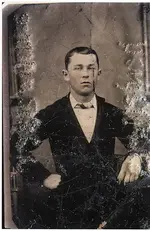
Das Luca photo of young Jacob Waltz
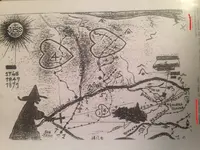
Das Luca (Jean Paul Gagne Jesuit Map
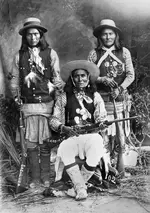
White Mountain Apache Das Luca on the left
also in the photo are, Skro-Kit and Shus-El-Day
Das Luca, (JP Gagne) was the man who owned and later sold the Jacob Waltz tin type photograph.
Das Luca said he acquired that photo from a man named Bud Dunn who found it in an old Bible while digging in a tunnel near Rogers spring in the eastern Superstition Mountains. Dunn was working with Quentin "Ted" Cox at the time.
Das Luca (Jean Paul Gagne) also appears as the person who had possession of the Jesuit Treasure Map. How, where and when he acquired this map is known to but one or two people and they are not talking.
The name Das Luca was taken from a White Mountain Apache who had been a scout for the Army in the 1890's. He later worked for Al Seiber as a laborer building the Apache Trail as the Roosevelt Dam was being built.
The name Das Luca was the basis for a well known Dutchman Book author who uses “lucca” as the base of his email address.
Here we have three Das Luca connections, a tin type photograph, a Jesuit Map and an Apache Indian. Can anyone follow the dots and come up with the real Das Luca (Jean Paul Gagne) ?
I was able to.

Das Luca photo of young Jacob Waltz

Das Luca (Jean Paul Gagne Jesuit Map

White Mountain Apache Das Luca on the left
also in the photo are, Skro-Kit and Shus-El-Day
wrmickel1
Bronze Member
- Joined
- Nov 7, 2011
- Messages
- 1,854
- Reaction score
- 1,399
- Golden Thread
- 0
- Location
- Jamestown ND
- Detector(s) used
- Garrett 2500
- Primary Interest:
- Other
Apparently Das Luca claimed he received maps from a old Canadian Jesuit priest. That is the story I was told. I have no faith in them. The priest on the one map indicates the map was made after Travis carved the priest horse stone. I have a large collection of Superstition maps and only 4 lead to something. All old mines or placer gold deposits. There is no doubt in my mind the map stones were made using the Peg Leg map for reference by Travis. The Peg Leg map led me to some old silver mines and placer in the Hewitt area. Woody and I uncovered a old silver mine that was hidden at the end of the stone map trail. Believe what you like about the stones trail maps. As far as I know I'm the only one that can show gold and old silver mines after using them. That's good enough for me.
Sarg,
I highly beg to differ, You are correct about the gold placers and the Silver mine in Hewitt area, But I've never been there
So I'm gonna tell you where your drop zone is, Don't know if this will make since to you or not. As the Turkey is to my area your zone would be as depicted on the witch map if read right. The Elephant, Does the Elephant mean anything in your area. Now Peg legs Map Has some in commons with the Stones, but it's not complete so I'll say it's a interpretation of the maps as well.
And the horse stone is real too, I'll walk you right up to it someday if you want.
Good of luck and find more gold!
Babymick1
sgtfda
Bronze Member
Sarg,
I highly beg to differ, You are correct about the gold placers and the Silver mine in Hewitt area, But I've never been there
So I'm gonna tell you where your drop zone is, Don't know if this will make since to you or not. As the Turkey is to my area your zone would be as depicted on the witch map if read right. The Elephant, Does the Elephant mean anything in your area. Now Peg legs Map Has some in commons with the Stones, but it's not complete so I'll say it's a interpretation of the maps as well.
And the horse stone is real too, I'll walk you right up to it someday if you want.
Good of luck and find more gold!
Babymick1
Elephant butte and 3 miles east a placer. But that was named long after
wrmickel1
Bronze Member
- Joined
- Nov 7, 2011
- Messages
- 1,854
- Reaction score
- 1,399
- Golden Thread
- 0
- Location
- Jamestown ND
- Detector(s) used
- Garrett 2500
- Primary Interest:
- Other
Is there a Arch there
sgtfda
Bronze Member
Elephant ear arches a bit north of some placer on the left of Hewitt Canyon Rd as you exit the main canyon. The arches are across from the marble mine
wrmickel1
Bronze Member
- Joined
- Nov 7, 2011
- Messages
- 1,854
- Reaction score
- 1,399
- Golden Thread
- 0
- Location
- Jamestown ND
- Detector(s) used
- Garrett 2500
- Primary Interest:
- Other
Silver or goldmine
sgtfda
Bronze Member
The marble mine produced a marble like stone. Forgot which type
sailaway
Hero Member
- Joined
- Mar 2, 2014
- Messages
- 623
- Reaction score
- 816
- Golden Thread
- 0
- Primary Interest:
- All Treasure Hunting
will help out, here are pics of the canyon.
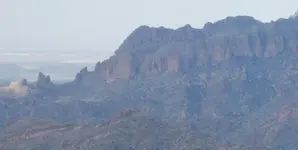
Elephant Butte and Black Point (is the drawing Waltz made depicting Black Point formation? indicating which canyon to follow)
Clue: Mary the donkey has been on the very old foot trail from Whitlow Canyon over Elephant Butte. Follow Milk Ranch road north then take right hand trail to two mines. Go over the ridge and enter the Hidden Canyon, the trail at this point is the boundary line for the Wilderness. Past the ridge you come to Eagle Springs then the Arch. End of the ridge is the JF Ranch and Woodbury Trail Head.
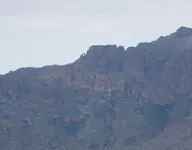
Arch above Rattle Snake Springs
Pictures were taken from the pass at Rogers Through Trail Head

Elephant Butte and Black Point (is the drawing Waltz made depicting Black Point formation? indicating which canyon to follow)
Clue: Mary the donkey has been on the very old foot trail from Whitlow Canyon over Elephant Butte. Follow Milk Ranch road north then take right hand trail to two mines. Go over the ridge and enter the Hidden Canyon, the trail at this point is the boundary line for the Wilderness. Past the ridge you come to Eagle Springs then the Arch. End of the ridge is the JF Ranch and Woodbury Trail Head.

Arch above Rattle Snake Springs
Pictures were taken from the pass at Rogers Through Trail Head
Last edited:
markmar
Silver Member
- Joined
- Oct 17, 2012
- Messages
- 4,279
- Reaction score
- 6,516
- Golden Thread
- 0
- Primary Interest:
- All Treasure Hunting
Matthew
You wrote : " Here we have three Das Luca connections, a tin type photograph, a Jesuit Map and an Apache Indian. Can anyone follow the dots and come up with the real Das Luca (Jean Paul Gagne) ?
I was able to."
Can you tell us who is the real Das Luca ( JPG ) , or is a confidential note ?
You wrote : " Here we have three Das Luca connections, a tin type photograph, a Jesuit Map and an Apache Indian. Can anyone follow the dots and come up with the real Das Luca (Jean Paul Gagne) ?
I was able to."
Can you tell us who is the real Das Luca ( JPG ) , or is a confidential note ?
Similar threads
- Replies
- 41
- Views
- 2K
- Replies
- 105
- Views
- 44K
- Replies
- 14
- Views
- 3K
Users who are viewing this thread
Total: 2 (members: 0, guests: 2)

